
copyright © Wartime Heritage Association
Website hosting courtesy of Register.com - a web.com company
Wartime Heritage
ASSOCIATION
The battles of the western front are the stories of trench warfare and over the years much has been written about those
trenches, the combatants, the weaponry, the strategy, and the battles. For the student of wartime history one way to truly
understand what happened between 1914 and 1918 in trench warfare can be found not in the history books, the regimental
records, and diaries but rather in the letters written from the heart by young men to their mothers, fathers, wives and
sweethearts and the letters written to families at the time of the soldier’s death.
Many young men from Yarmouth, Nova Scotia, Canada fought in the trenches of World War I. These are but a few letters that
tell their story. Killed in the Trenches of World War I, presents descriptions of the daily life, feelings, and the tragedy of death.
The letters and the pictures are randomly selected to portray the vivid story of life and death in the trenches of World War I

Credit: Canada. Dept. of National Defence/Library and Archives Canada
(Canadian Troops returning from the trenches; wet and covered with mud,
November, 1916.)
Lieutenant Frank Cann
85th Battalion
Aged 23
South Ohio, Yarmouth Co. Nova Scotia.
Died January 1918
“
...
On
his
return
to
France
as
an
officer
he
was
even
a
greater
help
to
the
battalion,
first
as
Lewis
gun
officer
and
then
when
the
position
of
intelligence
and
scout
officer
became
vacant
he
expressed
a
desire
for
this
position
which,
you
will
understand,
is
a
very
important
one
in
the
battalion
and
could
only
be
given
to
an
officer
of
exceptional
courage ...
We
went
into
the
line
and
the
first
night
we
went
out
in
No
Man's
Land
with
a
patrol.
He
received
a
very
serious
wound
by
rifle
or
machine
gun
bullets
in
the
vicinity
of
stomach.
A
stretcher
party
at
once
went
out
and
brought
him
in
and
he
was
rushed
out
of
the
line
as
quickly
as
possible.
Our
medical
officer,
whom
I
consulted
at
the
time,
said
the
wound
was
very
serious
but
that
he
was
putting
up
such
a
game
struggle,
was
so
strong
physically
and
had
lived
such
a clean life that possibly he had a slight chance ...”
Lieutenant Colonel A.H. Bordon
Commanding 85th Canadian Infantry Battalion
“It
was
nearly
midnight
on
the
14th
-
15th
when
word
came
to
the
dressing
station
that
Lieutenant
Cann
had
been
wounded
while
out
on
a
patrol
and
the
stretcher
bearers
could
not
get
him
through
the
trenches
on
account
of
the
narrowness.
So
Captain
Brown
and
I
immediately
went
out
with
our
dressings
accompanied
by
two
runners.
When
we
reached
the
dugout
to
which
place
they
had
taken
Frank
he
was
comfortable
on
a
stretcher.
We
immediately
dressed
the
wound
and
placed
a
clean
dry
blanket
under
and
over
him.
The
medical
officer
gave
him
a
hypodermic
injection to relieve his pain.
He
was
quite
cheerful
and
spoke
to
us
and
was
resting
nicely.
However,
the
stretcher
bearers
were
right
there
and
we
placed
an
emergency
ticket
on
him
and
he
was
rushed
right
out.
On
account
of
the
snow
on
the
ground
many
of
the
officers
and
men
were
dressed
in
all
white
and
I
must
tell
you
that
Frank
looked
awfully
pale.
I
readily
noticed
that
he
always
had such a high colour.
We
held
very
little
hope
for
his
recovery
as
the
wound
was
severe,
two
machine
gun
bullets
having
gone
right
through
the
abdomen.
Indeed,
we
all
felt
badly
to
hear
that
Lieutenant
Cann
had
passed
away
at No 57 Casualty Station (C C S) on the 15th.”
Sergeant S.F. Williams
Medical Orderly
Credit: Canada. Dept. of National Defence/Library and Archives Canada
(Resting in Reserve Trenches, 2nd Canadian Field Ambulance. June,
1916.)

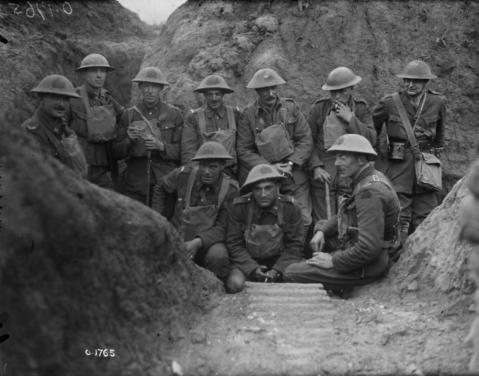
Credit: Canada. Dept. of National Defence/Library and Archives Canada
(Officer giving his men advice in trenches. August, 1917.)
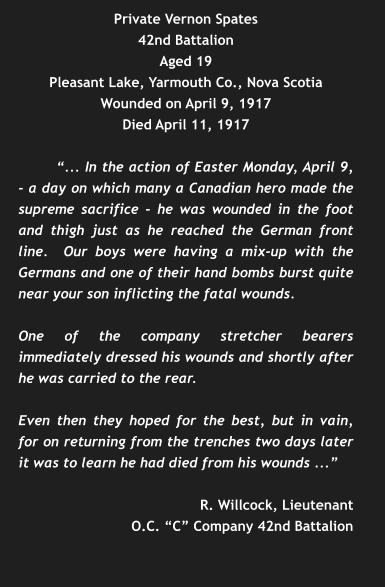
James Wilbur Dexter
85th Battalion
Aged 23
East Benton, Yarmouth County, Nova Scotia
Died June 15, 1917
“...
I
must
say
that
I
was
Jim’s
comrade
and
chum
in
France.
We
were
both
scouts
and
were
always
together.
We
fought
together,
we
rested
together,
we
ate
together
and
we
slept
together.
Needless
to
say
under
the
trying
circumstances
we
were
the
lost
intimate
of
friends
and
the
truest
of
pals.
Even
yet
I
long
for
the
companionship
of
one
so
true
who
lived
so nobly and died so gloriously. ...
I
as
gassed
by
the
same
shell
that
Jim
was,
only
not
nearly
so
badly
and
I
was
with
him
until
almost
the
last.
When
the
stretcher
bearers
took
him
out
of
the
trenches
for
the
trip
to
the
hospital
he
was
unconscious.
He
was
brave
to
the
last
and
died
with
the
spirit
of
fight
until
the
wrongs
done
to
Christianity and humanity were redressed. ...”
Hartley E. Scott
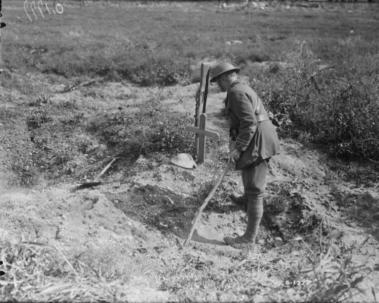
Credit: Canada. Dept. of National Defence/Library and Archives Canada/
(Grave of a Canadian in what was No Man's Land; August, 1917)
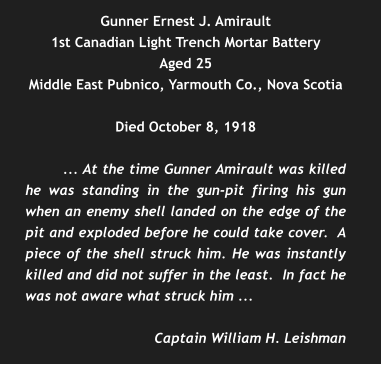
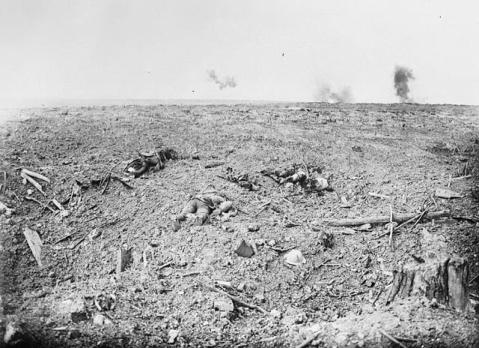
Credit: W.I. Castle / Canada. Dept. of National Defence / Library and Archives Canada / PA-000786
(1st Battle of the Somme, France, 1916. "No Man's Land" in front of Canadian lines.)
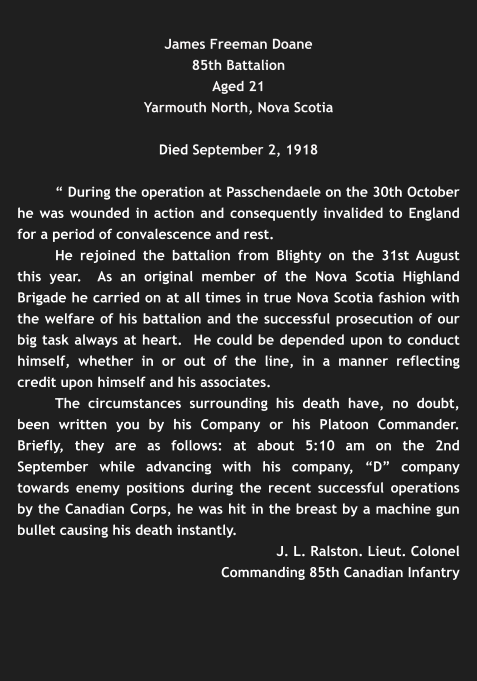
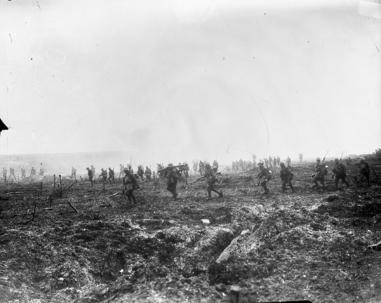
Canada. Dept. of National Defence/Library and Archives Canada/PA-001086
(29th Infantry Battalion advancing over "No Man's Land" through the
German barbed wire and heavy fire during the battle of Vimy
Ridge.)


Credit: Canada. Dept. of National Defence/Library and Archives Canada
(Canadian troops returning from the trenches. November, 1916.
1st Battle of the Somme.)


Canada. Dept. of National Defence/Library and Archives Canada
(Canadians resting in captured trenches in front of Arras.
Advance East of Arras. August, 1918.)
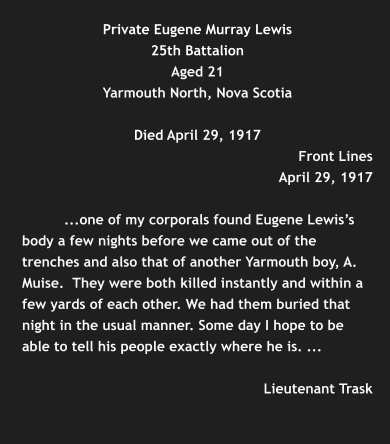
Killed in the Trenches
of World War I


- World War I - Menu
- WWI Stories and Articles
- Photos - Yarmouth Soldiers
- Selection of World War I Songs
- WWI Casualties of Yarmouth, NS
- Those Who Served - Yarmouth, NS
- WWI Casualties Digby Co. NS
- WWI Casualties Shelburne Co. NS
- Merchant Mariners (1915) Yarmouth, NS
- Canadian Forestry Corps - Non Yarmouth Birth/Residence Enlistments
- US Draft Registry - Yarmouth NS Born


- World War II - Menu
- WWII Stories and Articles
- Telegraphist Air Gunners
- WWII Casualties of Nova Scotia
- US Casualties with NS Connection
- Far East/Pacific Casualties with NS Connection
- Merchant Navy Casualties Nova Scotia
- Nova Scotia WWII Casualties Holten Canadian War Cemetery
- D-Day Casualties - Nova Scotia
- CANLOAN Program Casualties - Nova Scotia
- Battle of the Bulge Casualties - Nova Scotia
- WWII Casualties Yarmouth NS
- Yarmouth Casualties - RCAF RAF Canadian Army WWII
- Yarmouth Co., Marriages WWII
- Casualties Non-Born/Residents with Connection to Yarmouth Co., Nova Scotia.
- WWII Casualties Digby Co., NS
- Non-Nova Scotian WWII Casualties Buried in Nova Scotia
- WWII RCAF Casualties Aged 16-18
- Brothers/Sisters Who Served - World War II














